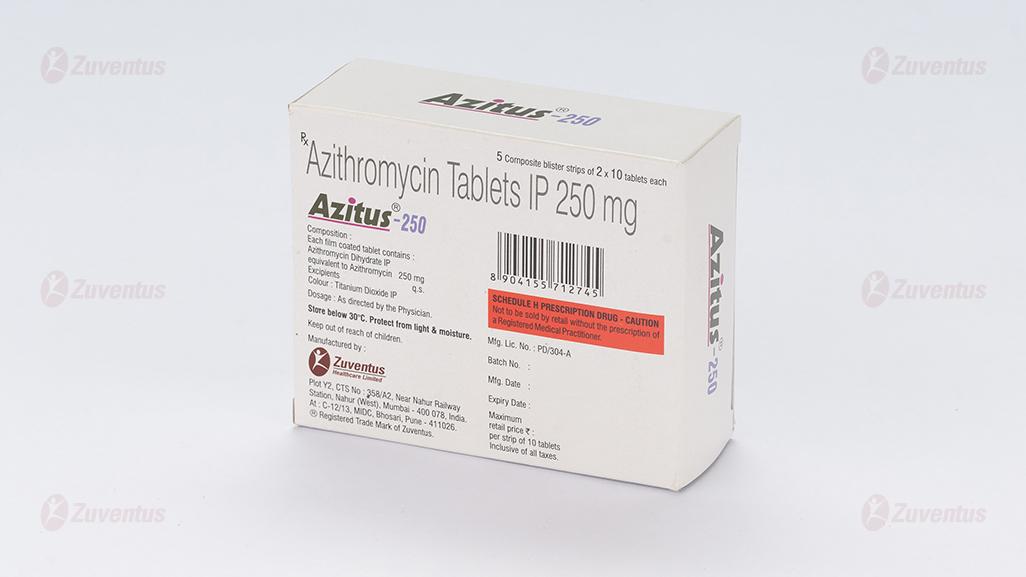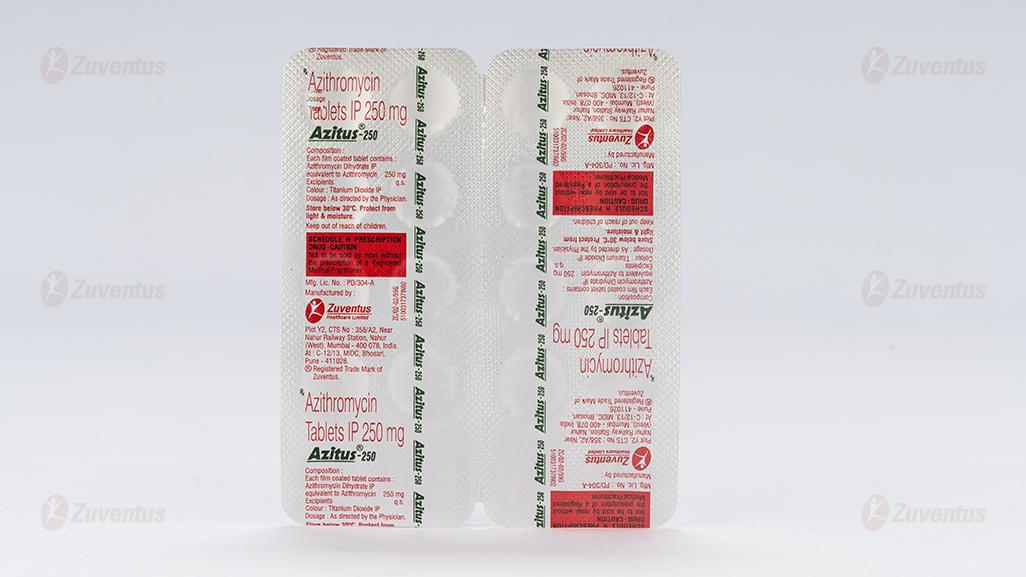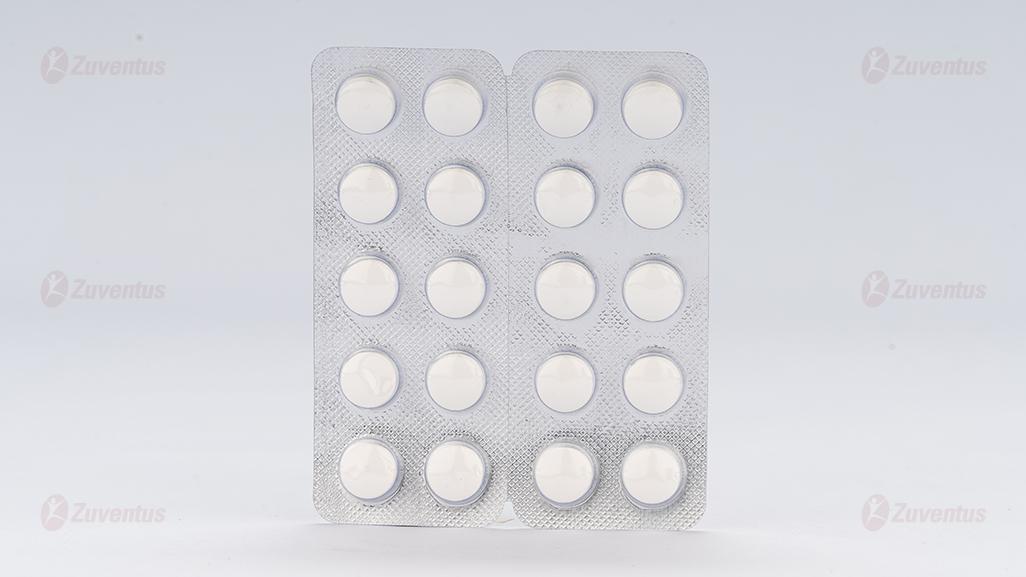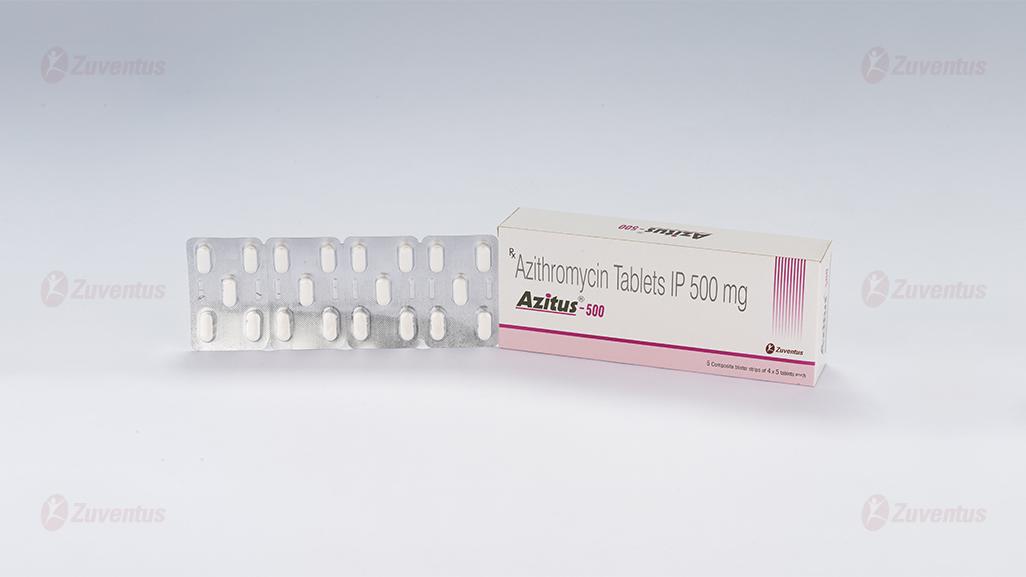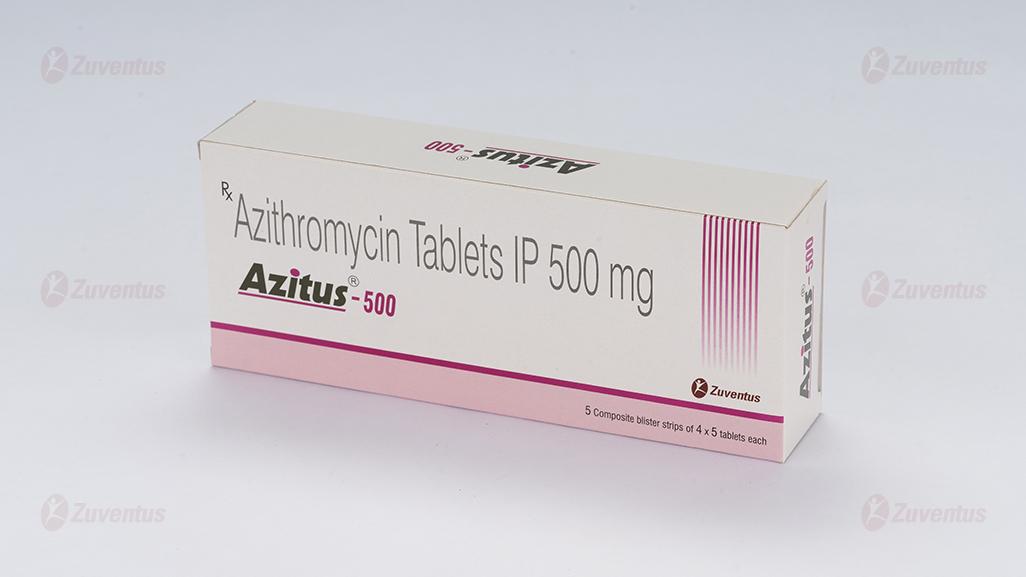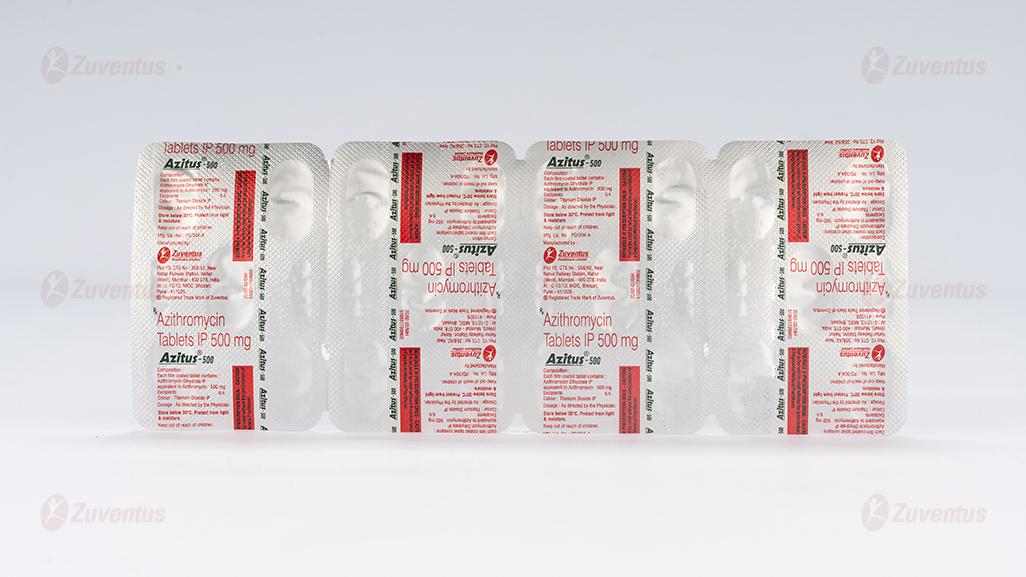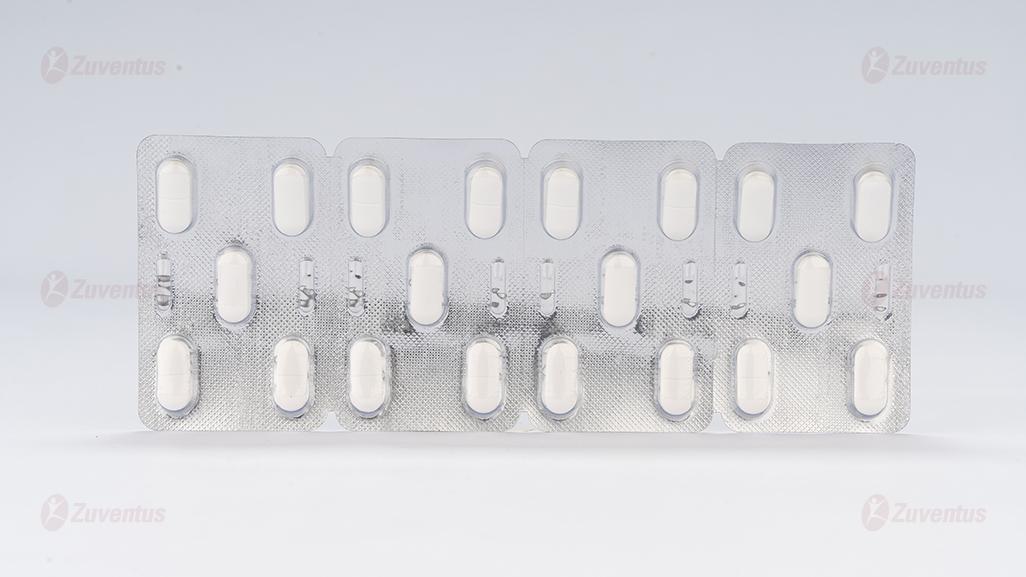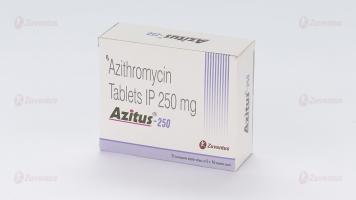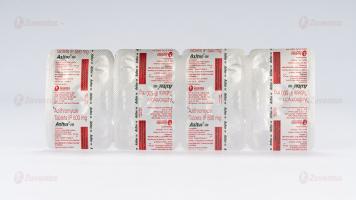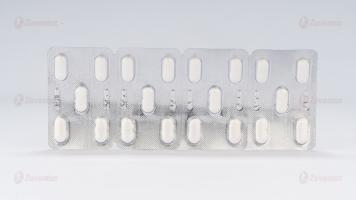Azitus 250 and 500 Tablets
Therapy Area
Anti Infective
1.0 Generic name
Azithromycin Tablets IP 250 mg / 500 mg
2.0 Qualitative and quantitative composition
Azitus 250
Each film coated tablet contains :
Azithromycin Dihydrate IP
equivalent to Azithromycin 250 mg
Excipients q.s.
Colour : Titanium Dioxide IP
Azitus 500
Each film coated tablet contains :
Azithromycin Dihydrate IP
equivalent to Azithromycin 500 mg
Excipients
Colour : Titanium Dioxide IP
3.0 Dosage form and strength
Tablet 250 / 500 mg
4.0 Clinical particulars
4.1 Therapeutic indication
- Uncomplicated multidrug resistant enteric fever only
- Acute bacterial sinusitis.
- Acute bacterial otitis media
- Pharyngitis, tonsillitis
- Acute exacerbation of chronic bronchitis
- Mild to moderately severe community acquired pneumonia
- Skin and soft tissue infections
- Uncomplicated Chlamydia trachomatis urethritis and cervicitis
Considerations should be given to official guidance on the appropriate use of antibacterial agents
4.2 Posology and method of administration
Azithromycin should be given as a single daily dose. Duration of the treatment for the different infection diseases is given below.
Adults, children and adolescents with a body weight of 45 kg or over
The total dose is 1500 mg, administered as 500 mg once daily for 3 days. Alternatively, the same total dose (1500 mg) can be administered in a period of 5 days, 500 mg on the first day and 250 mg on day 2 to 5. In the case of uncomplicated Chlamydia trachomatis urethritis and cervicitis, the dosage is 1000 mg as a single oral dose.
For patients who are allergic to penicillin and/or cephalosporins, prescribers should consult local treatment guidelines.
Children and adolescents with a body weight below 45 kg
Azithromycin tablets are not suitable for patients under 45 kg body weight. Other dosage forms are available for this group of patients.
Elderly patients
For elderly patients the same dose as for adults can be applied. Since elderly patients can be patients with ongoing proarrhythmic conditions a particular caution is recommended due to the risk of developing cardiac arrhythmia and torsades de pointes
Patients with renal impairment
Dose adjustment is not required in patients with mild to moderate renal impairment (GFR 10-80 ml/min). Caution should be exercised when Azithromycin is administered to patients with severe renal impairment (GFR < 10 ml/min).
Patients with hepatic impairment
Since Azithromycin is metabolised in the liver and excreted in the bile, the drug should not be given to patients suffering from severe liver disease. No studies have been conducted regarding treatment of such patients with Azithromycin.
Method of administration
Azithromycin film-coated tablets are for oral administration only. The tablets can be taken with or without food. The tablets should be taken with ½ glass of water
4.3 Contraindications
Hypersensitivity to Azithromycin, Erythromycin, any Macrolide or Ketolide antibiotic, or to any of the excipient listed in the formulation.
4.4 Special warnings and precautions for use
Hypersensitivity
As with Erythromycin and other Macrolides, rare serious allergic reactions including angioneurotic oedema and anaphylaxis (rarely fatal), dermatologic reactions including Acute Generalised Exanthematous Pustulosis (AGEP), Stevens Johnson Syndrome (SJS), Toxic Epidermal Necrolysis (TEN) (rarely fatal) and Drug Reaction with Eosinophilia and Systemic Symptoms (DRESS) have been reported. Some of these reactions with Azithromycin have resulted in recurrent symptoms and required a longer period of observation and treatment. If an allergic reaction occurs, the drug should be discontinued and appropriate therapy should be instituted. Physicians should be aware that reappearance of the allergic symptoms may occur when symptomatic therapy is discontinued.
Hepatotoxicity
Since the liver is the principal route of elimination for Azithromycin, the use of Azithromycin should be undertaken with caution in patients with significant hepatic disease. Cases of fulminant hepatitis potentially leading to lifethreatening liver failure have been reported with Azithromycin. Some patients may have had pre-existing hepatic disease or may have been taking other hepatotoxic medicinal products. In case of signs and symptoms of liver dysfunction, such as rapid developing asthenia associated with jaundice, dark urine, bleeding tendency or hepatic encephalopathy, liver function tests / investigations should be performed immediately. Azithromycin administration should be stopped if liver dysfunction has emerged.
Ergot derivatives
In patients receiving Ergot derivatives, Ergotism has been precipitated by co-administration of some macrolide antibiotics. There are no data concerning the possibility of an interaction between ergotamine derivatives and Azithromycin. However, because of the theoretical possibility of Ergotism, Azithromycin and Ergot derivatives should not be co-administered.
Prolongation of the QT interval
Prolonged cardiac repolarisation and QT interval, imparting a risk of developing cardiac arrhythmia and torsades de pointes, have been seen in treatment with other macrolides. A similar effect with Azithromycin cannot be completely ruled out in patients at increased risk for prolonged cardiac repolarisation; therefore, caution is required when treating patients :
- With congenital or documented QT prolongation.
- Currently receiving treatment with other active substances known to prolong QT interval such as antiarrhythmics of classes Ia and III, Cisapride and Terfenadine.
- With electrolyte disturbance, particularly in cases of hypokalaemia and hypomagnesaemia
- With clinically relevant bradycardia, cardiac arrhythmia or severe cardiac insufficiency
Superinfection
As with any antibiotic preparation, observation for signs of superinfection with non-susceptible organisms including fungi is recommended.
Clostridium difficile associated diarrhoea
Clostridium difficile associated diarrhoea (CDAD) has been reported with the use of nearly all antibacterial agents, including Azithromycin, and may range in severity from mild diarrhoea to fatal colitis. Strains of C. difficile producing hypertoxins A and B contribute to the development of CDAD. Hypertoxin producing strains of C. difficile cause increased morbidity and mortality, as these infections can be refractory to antimicrobial therapy and may require colectomy. Therefore, CDAD must be considered in patients who present with diarrhoea during or subsequent to the administration of any antibiotics. Careful medical history is necessary since CDAD has been reported to occur over two months after the administration of antibacterial agents. Discontinuation of therapy with Azithromycin and the administration of specific treatment for C. difficile should be considered.
Streptococcal infections
Penicillin is usually the first choice for treatment of pharyngitis/tonsillitis due to Streptococcus pyogenes and also for prophylaxis of acute rheumatic fever. Azithromycin is in general effective against streptococcus in the oropharynx, but no data are available that demonstrate the efficacy of Azithromycin in preventing acute rheumatic fever.
Renal impairment
In patients with severe renal impairment (GFR < 10 ml/min) a 33% increase in systemic exposure to Azithromycin was observed.
Myasthenia gravis
Exacerbations of the symptoms of myasthenia gravis and new onset of myasthenia syndrome have been reported in patients receiving azithromycin therapy. Co-administration with Hydroxychloroquine or Chloroquine
Carefully consider the balance of benefits and risks before prescribing Azithromycin for any patients taking Hydroxychloroquine or Chloroquine, because of the potential for an increased risk of cardiovascular events and cardiovascular mortality.
4.5 Drugs interactions
Antacids
In a pharmacokinetic study investigating the effects of simultaneous administration of antacids with Azithromycin, no effect on overall bioavailability was seen, although peak serum concentrations were reduced by approximately 24%. In patients receiving both Azithromycin and antacids, the drugs should not be taken simultaneously.
Cetirizine
In healthy volunteers, co-administration of a 5-day regimen of Azithromycin with 20 mg Cetirizine at steady-state resulted in no pharmacokinetic interaction and no significant changes in the QT interval.
Didanosine (Dideoxyinosine)
Co-administration of 1200 mg/day Azithromycin with 400 mg/day Didanosine in 6 HIV-positive subjects did not appear to affect the steady-state pharmacokinetics of Didanosine as compared with placebo.
Digoxin and Colchicine
Concomitant administration of macrolide antibiotics, including Azithromycin, with P-glycoprotein substrates such as Digoxin and Colchicine, has been reported to result in increased serum levels of the P-glycoprotein substrate. Therefore, if Azithromycin and P-glycoprotein substrates such as Digoxin are administered concomitantly, the possibility of elevated serum Digoxin concentrations should be considered. Clinical monitoring, and possibly serum Digoxin levels, during treatment with Azithromycin and after its discontinuation are necessary.
Zidovudine
Single 1000 mg doses and multiple 1200 mg or 600 mg doses of Azithromycin had little effect on the plasma pharmacokinetics or urinary excretion of Zidovudine or its glucuronide metabolite. However, administration of Azithromycin increased the concentrations of phosphorylated Zidovudine, the clinically active metabolite, in peripheral blood mononuclear cells. The clinical significance of this finding is unclear, but it may be of benefit to patients.
Azithromycin does not interact significantly with the hepatic cytochrome P450 system. It is not believed to undergo the pharmacokinetic drug interactions as seen with Erythromycin and other macrolides. Hepatic cytochrome P450 induction or inactivation via cytochrome-metabolite complex does not occur with Azithromycin.
Ergot derivatives
Due to the theoretical possibility of ergotism, the concurrent use of Azithromycin with Ergot derivatives is not recommended. Pharmacokinetic studies have been conducted between Azithromycin and the following drugs known to undergo significant cytochrome P450 mediated metabolism.
Atorvastatin
Co-administration of Atorvastatin (10 mg daily) and Azithromycin (500 mg daily) did not alter the plasma concentrations of Atorvastatin (based on a HMG CoA-reductase-inhibition assay).
Carbamazepine
In a pharmacokinetic interaction study in healthy volunteers, no significant effect was observed on the plasma levels of Carbamazepine or its active metabolite in patients receiving concomitant Azithromycin.
Cimetidine
In a pharmacokinetic study investigating the effects of a single dose of Cimetidine, given 2 hours before Azithromycin, on the pharmacokinetics of Azithromycin, no alteration of Azithromycin pharmacokinetics was seen.
Coumarin-type oral anticoagulants
In a pharmacokinetic interaction study, Azithromycin did not alter the anticoagulant effect of a single dose of 15 mg Warfarin administered to healthy volunteers. There have been reports received in the post-marketing period of potentiated anticoagulation subsequent to co-administration of Azithromycin and Coumarin-type oral anticoagulants. Although a causal relationship has not been established, consideration should be given to the frequency of monitoring prothrombin time when Azithromycin is used in patients receiving Coumarin-type oral anticoagulants.
Ciclosporin
In a pharmacokinetic study with healthy volunteers that were administered a 500 mg/day oral dose of Azithromycin for 3 days and were then administered a single 10 mg/kg oral dose of Ciclosporin, the resulting Ciclosporin Cmax and AUC0-5were found to be significantly elevated (by 24% and 21% respectively), however no significant changes were seen in AUC0-∞. Consequently, caution should be exercised before considering concurrent administration of these drugs. If co-administration of these drugs is necessary, Ciclosporin levels should be monitored and the dose adjusted accordingly.
Efavirenz
Co-administration of a single dose of 600 mg Azithromycin and 400 mg Efavirenz daily for 7 days did not result in any clinically significant pharmacokinetic interactions.
Fluconazole
Co-administration of a single dose of 1200 mg Azithromycin did not alter the pharmacokinetics of a single dose of 800 mg Fluconazole. Total exposure and half-life of Azithromycin were unchanged by the co-administration of Fluconazole, however, a clinically insignificant decrease in Cmax (18%) of Azithromycin was observed.
Indinavir
Co-administration of a single dose of 1200 mg Azithromycin had no statistically significant effect on the pharmacokinetics of Indinavir administered as 800 mg three times daily for 5 days.
Methylprednisolone
In a pharmacokinetic interaction study in healthy volunteers, Azithromycin had no significant effect on the pharmacokinetics of Methylprednisolone.
Midazolam
In healthy volunteers, co-administration of Azithromycin 500 mg/day for 3 days did not cause clinically significant changes in the pharmacokinetics and pharmacodynamics of a single 15 mg dose of Midazolam.
Nelfinavir
Co-administration of Azithromycin (1200 mg) and Nelfinavir at steady state (750 mg three times daily) resulted in increased Azithromycin concentrations. No clinically significant adverse effects were observed and no dose adjustment was required.
Rifabutin
Co-administration of Azithromycin and Rifabutin did not affect the serum concentrations of either drug. Neutropenia was observed in subjects receiving concomitant treatment of Azithromycin and Rifabutin. Although neutropenia has been associated with the use of Rifabutin, a causal relationship to combination with Azithromycin has not been established.
Sildenafil
In normal healthy male volunteers, there was no evidence of an effect of Azithromycin (500 mg daily for 3 days) on the AUC and Cmax of Sildenafil or its major circulating metabolite.
Terfenadine
Pharmacokinetic studies have reported no evidence of an interaction between Azithromycin and Terfenadine. There have been rare cases reported where the possibility of such an interaction could not be entirely excluded; however, there was no specific evidence that such an interaction had occurred.
Theophylline
There is no evidence of a clinically significant pharmacokinetic interaction when Azithromycin and Theophylline are co-administered to healthy volunteers.
Triazolam
In 14 healthy volunteers, co-administration of Azithromycin 500 mg on Day 1 and 250 mg on Day 2 with 0.125 mg Triazolam on Day 2 had no significant effect on any of the pharmacokinetic variables for Triazolam compared to Triazolam and placebo.
Trimethoprim / Sulfamethoxazole
Co-administration of Trimethoprim/Sulfamethoxazole DS (160 mg/800 mg) for 7 days with Azithromycin 1200 mg on Day 7 had no significant effect on peak concentrations, total exposure or urinary excretion of either Trimethoprim or Sulfamethoxazole. Azithromycin serum concentrations were similar to those seen in other studies.
Hydroxychloroquine and Chloroquine
Observational data have shown that co-administration of Azithromycin with Hydroxychloroquine in patients with rheumatoid arthritis is associated with an increased risk of cardiovascular events and cardiovascular mortality. Carefully consider the balance of benefits and risks before prescribing Azithromycin for any patients taking Hydroxychloroquine. Similar careful consideration of the balance of benefits and risk should also be undertaken before prescribing Azithromycin for any patients taking Chloroquine, because of the potential for a similar risk with Chloroquine.
4.6 Use in special populations
Pregnancy
Animal reproduction studies have been performed at doses up to moderately maternally toxic dose concentrations. In these studies, no evidence of harm to the foetus due to Azithromycin was found. There are, however, no adequate and well-controlled studies in pregnant women. Because animal reproduction studies are not always predictive of human response, Azithromycin should be used during pregnancy only if clearly needed.
Breast-feeding
Limited information available from published literature indicates that Azithromycin is present in human milk at an estimated highest median daily dose of 0.1 to 0.7 mg/kg/day. No serious adverse effects of Azithromycin on the breast-fed infants were observed. A decision must be made whether to discontinue breast-feeding or to discontinue/abstain from Azithromycin therapy taking into account the benefit of breast-feeding for the child and the benefit of therapy for the woman.
4.7 Effects on ability to drive and use machines
No data are available regarding the influence of Azithromycin on a patient's ability to drive or operate machinery. However, the possibility of undesirable effects like dizziness and convulsions should be taken into account when performing these activities.
4.8 Undesirable effects
Azithromycin is well tolerated with a low incidence of side effects
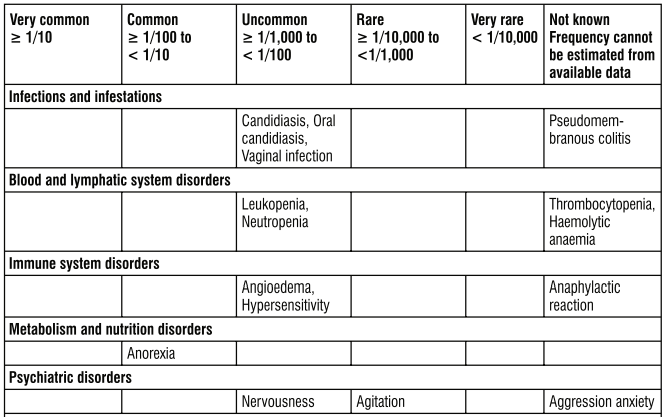
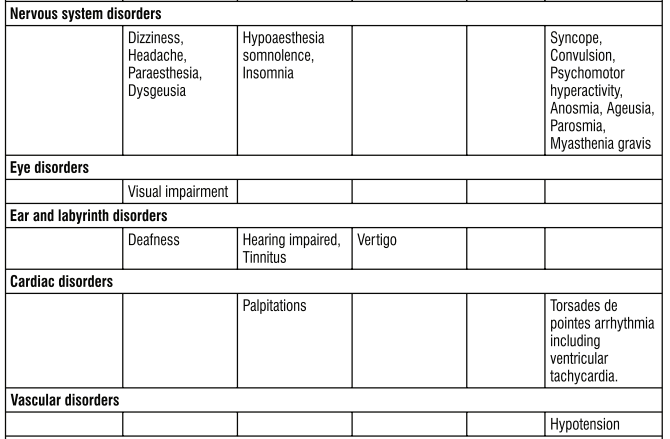
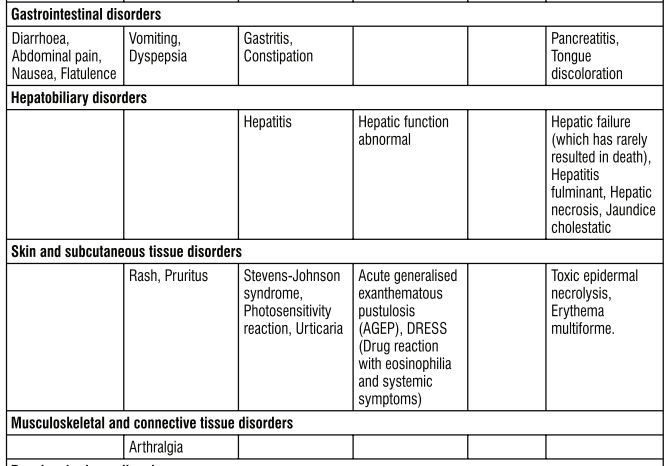

Reporting of suspected adverse reactions
Reporting suspected adverse reactions after authorisation of the medicinal product is important. It allows continued monitoring of the benefit/risk balance of the medicinal product. Healthcare professionals are asked to report any suspected adverse reactions via email to: medico@zuventus.com
4.9 Overdose
Adverse events experienced in higher than recommended doses were similar to those seen at normal doses.
Symptoms
The typical symptoms of an overdose with macrolide antibiotics include reversible loss of hearing, severe nausea, vomiting and diarrhoea.
Treatment
In the event of overdose, the administration of medicinal charcoal and general symptomatic treatment and supportive measures are indicated as required.
5.0 Pharmacological properties
5.1 Mechanism of action
The mechanism of action of Azithromycin is based upon the suppression of bacterial protein synthesis by means of binding to the ribosomal 50S sub-unit and inhibition of peptide translocation.
5.2 Pharmacodynamic properties
The prevalence of acquired resistance may vary geographically and with time for selected species and local information on resistance is desirable, particularly when treating severe infections. As necessary, expert advice should be sought when the local prevalence of resistance is such that the utility of the agent in at least some types of infections is questionable
Table : Antibacterial spectrum of Azithromycin

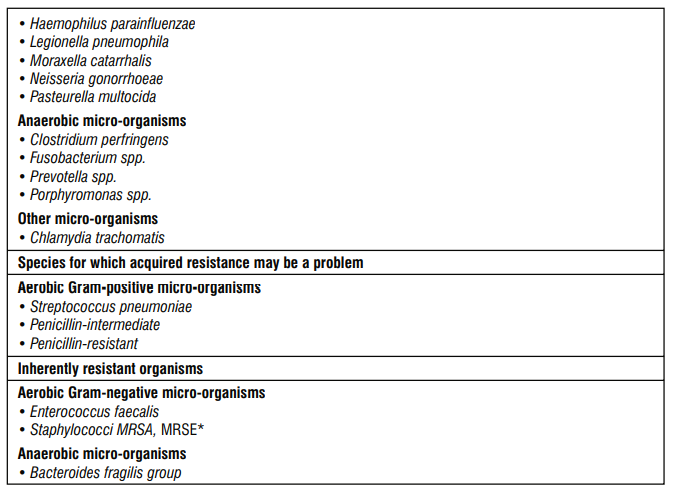
Methycillin-resistant staphylococci have a very high prevalence of acquired resistance to macrolides and have been placed here because they are rarely susceptible to Azithromycin.
5.3 Pharmacokinetic properties
Absorption
Bioavailability of Azithromycin after oral administration is approximately 37%. Peak plasma concentrations are attained after 2 - 3 hours. The mean maximum concentration observed (Cmax) after a single dose of 500 mg is approximately 0.4 μg/ml.
Distribution
Orally administered Azithromycin is widely distributed throughout the body. In pharmacokinetic studies it has been demonstrated that the concentrations of Azithromycin measured in tissues are noticeably higher (as much as 50 times) than those measured in plasma, which indicates that the agent strongly binds to tissues. Binding to serum proteins varies according to plasma concentration and ranges from 12% at 0.5 microgram/ml up to 52% at 0.05 microgram Azithromycin/ml serum. The mean volume of distribution at steady state (VVSS) has been calculated to be 31.1 l/kg.
At the recommended dose no accumulation appears in the serum. Accumulation appears in tissues where levels are much higher than in serum. Three days after administration of 500 mg as a single dose or in partial doses concentrations of 1,3 - 4,8 μg/g, 0,6 - 2,3 μg/g, 2,0 - 2,8 μg/g and 0 - 0,3 μg/ml have been measured in resp. lung, prostate, tonsil and serum.
Elimination
The terminal plasma elimination half-life closely reflects the elimination half-life from tissues of 2 - 4 days. Approximately 12% of an intravenously administered dose is excreted in unchanged form with the urine over a period of 3 days; the major proportion in the first 24 hours. Concentrations of up to 237 μg/ml Azithromycin, 2 days after a 5-day course of treatment, have been found in human bile. Ten metabolites have been identified (formed by N- and O-demethylation, by Hydroxylation of the desosamine and aglycone rings, and by splitting of the cladinose conjugate). Investigations suggest that the metabolites do not play a role in the microbiological activity of Azithromycin.
6.0 Nonclinical properties
6.1 Animal toxicology or pharmacology
Phospholipidosis (intracellular phospholipid accumulation) has been observed in several tissues (e.g. eye, dorsal root ganglia, liver, gallbladder, kidney, spleen, and/or pancreas) of mice, rats, and dogs given multiple doses of Azithromycin. Phospholipidosis has been observed to a similar extent in the tissues of neonatal rats and dogs. The effect has been shown to be reversible after cessation of Azithromycin treatment. The relevance of this finding to humans receiving Azithromycin in accordance with the recommendations is unknown. Electrophysiological investigations have shown that Azithromycin prolongs the QT interval
Carcinogenic potential
Long-term studies in animals have not been performed to evaluate carcinogenic potential as the drug is indicated for short-term treatment only and there were no signs indicative of carcinogenic activity.
Mutagenic potential
There was no evidence of a potential for genetic and chromosome mutations in in-vivo and in-vitro test models.
Reproductive toxicity
In animal studies for embryotoxic effects of the substance, no teratogenic effect was observed in mice and rats. In rats, Azithromycin doses of 100 and 200 mg/kg bodyweight/day led to mild retardation of foetal ossification and in maternal weight gain. In peri- and postnatal studies in rats, mild retardation following treatment with 50 mg/kg/day Azithromycin and above was observed.
7.0 Description
Azithromycin tablet contains the active ingredient Azithromycin, a macrolide antibacterial drug, for oral administration. Azithromycin has the,
Chemical name : (2R,3S,4R,5R,8R,10R,11R,12S,13S,14R)-13-[(2,6-dideoxy-3-C-methyl-3-O-methyl-α-L-ribohexopyranosyl)oxy]-2-ethyl- 3,4,10-trihydroxy-3,5,6,8,10,12,14-heptamethyl-11-[[3,4,6-trideoxy-3-
(dimethylamino)-β-D-xylo-hexopyranosyl]oxy]-1-oxa-6-azacyclopentadecan-15-one.
Molecular formula : C38H72N2O12
Molecular weight : 749.00 g/mol
8.0 Pharmaceutical particulars
8.1 Incompatibilities
Not applicable
8.2 Shelf-life
Refer on the pack.
8.3 Packaging information
Azitus 250 : A blister strip of 10 tablets.
Azitus 500 : A blister strip of 5 tablets.
8.5 Storage and handing instructions
Store below 30°C. Protect from light & moisture
Keep out of reach of children
9.0 Patient counselling information
Azithromycin tablets may be taken with or without food. However, increased tolerability has been observed when tablets are taken with food.
Patients should also be cautioned not to take Aluminium- and Magnesium-containing antacids and Azithromycin simultaneously
The patient should be directed to discontinue Azithromycin immediately and contact the Physician if any signs of an allergic reaction occur.
Patients should be counselled that antibacterial drugs, including Azithromycin, should only be used to treat bacterial infections. They do not treat viral infections (e.g., the common cold). When Azithromycin is prescribed to treat bacterial infection, patients should be told that although it is common to feel better early in the course of therapy, the medication should be taken exactly as directed. Skipping doses or not completing the full course of therapy may (1) decrease the effectiveness of the immediate treatment and (2) increase the likelihood that bacteria will develop resistance and will not be treatable by Azithromycin or other antibacterial drugs in the future.
Diarrhea is a common problem caused by antibacterial which usually ends when the antibiotic is discontinued. Sometimes after starting treatment with antibacterials, patients can develop watery and bloody stools (with or without stomach cramps and fever) even as late as two or more months after having taken the last dose of the antibacterial. If this occurs, patients should contact their physician as soon as possible.
About leaflet
Read all of this leaflet carefully before you start taking this medicine because it contains important information for you:
- Keep this leaflet. You may need to read it again.
- If you have any further questions, ask your doctor or pharmacist.
- This medicine has been prescribed for you only. Do not pass it on to others. It may harm them, even if their signs of illness are the same as yours.
- If you get any side effects, talk to your doctor or pharmacist. This includes any possible side effects not listed in this leaflet. See section 4.
What is in this leaflet
1. What AZITUS® is and what it is used for
2. What you need to know before you take AZITUS®
3. How to take AZITUS®
4. Possible side effects
5. How to store AZITUS®
6. Contents of the pack and other information
1. What AZITUS® is and what it is used for
This medicine contains azithromycin, which is one of a group of antibiotics called macrolides. Antibiotics are used to treat infections caused by micro-organisms like bacteria:
Azithromycin is used for the treatment of certain infections caused by bacteria that are sensitive to it, such as:
- chest, throat or nasal infections (such as bronchitis, pneumonia, tonsillitis, sore throat (pharyngitis) and sinusitis)
- ear infections
- skin and soft tissue infections, with exception of infected burn wounds
- infection of the tube that carries urine from the bladder (urethra) or the neck of the womb (cervix) caused by Chlamidia trachomatis bacteria)
You must talk to a doctor if you do not feel better or if you feel worse.
2. What you need to know before you take AZITUS®
Do not take AZITUS®:
- if you/your child are allergic to azithromycin dehydrate or any other macrolide antibiotic such as erythromycin or clarithromycin or any of the ingredients. An allergic reaction may cause skin rash or wheezing.
Warnings and precautions
Talk to your doctor or pharmacist before taking AZITUS® if you have or have had any of the following:
- you have ever had a serious allergic reaction causing swelling of the face and throat, possibly with breathing problems, rash, fever, swollen glands or an increase in eosinophils (a certain type of white blood cells)
- you develop severe and persistent diarrhoea during or after treatment
- you have severe liver or kidney problems
- you have severe heart problems or problems with your heart beat such as long QT syndrome (shown on an electro-cardiogram or ECG machine)
- your blood levels of potassium or magnesium are too low
- you develop signs of another infection
- you are taking any ergot derivatives such as ergotamine (to treat migraine) as these medicines should not be taken together with AZITUS®
- you have a certain type of muscle weakness called myasthenia gravis
- you have nervous (neurological) or mental (psychiatric) problems your newborn child develops vomiting and irritability during feeding
Other medicines and AZITUS®
Tell your doctor or pharmacist if you/your child are taking, have recently taken or might take any other medicines.
Antacids - used for heartburn and indigestion. Azithromycin should be taken at least 1 hour before or 2 hours after the antacid
Ergotamine -dihydroergotamine (used for migraine) should not be taken at the same time as serious side effects may develop (ergotism - i.e. itching in the limbs, muscle cramps and gangrene of hands and feet due to poor blood circulation)
Cholesterol lowering medicines (statins)
Warfarin or any similar medicines - to prevent blood clots: concomitant use can increase the risk of bleeding
Hydroxychloroquine (used to treat rheumatic diseases or malaria): heart problems may occur
Cisapride - (used to treat stomach problems), or terfenadine (used to treat hay fever): should not be taken at the same time as this may cause severe heart problems (shown on an electro-cardiogram or ECG machine)
Zidovudine or nelfinavir - used to treat HIV infections. Taking nelfinavir with Azithromycin may mean that you get more of the side effects listed in this leaflet
Rifabutin - used to treat tuberculosis (TB)
Quinidine - used to treat heart rhythm problems (called anti-arrythmics)
Cyclosporin - used to suppress the immune system to prevent and treat rejection of an organ or bone marrow transplant. Your doctor will regularly check your blood levels of cyclosporin and may change your dose.
Tell your doctor or pharmacist if you are taking any of the following medicines. Azithromycin can make the effects of these other medicines stronger. Your doctor may change your dose:
Alfentanil - a painkiller used e.g. during operations
Theophylline - used for breathing problems such as asthma and chronic obstructive pulmonary disease (COPD)
Digoxin - used to treat heart failure
Colchicine - used for gout and familial Mediterranean fever
Astemizol - used to treat hay fever
Pimozide - used to treat mental health problems
Azithromycin with food and drink
This medicine can be taken with or without food.
Pregnancy, breast-feeding and fertility
If you are pregnant or breastfeeding, think you may be pregnant or are planning to have a baby, ask your doctor or pharmacist for advice before taking this medicine. There is insufficient information available about the use of Azithromycin during pregnancy. Therefore, you should not use Azithromycin during pregnancy, unless explicitly advised by your doctor. Azithromycin is partially passed through the mother’s milk; it is not known whether azithromycin may have adverse effects on the breastfed infant. Breastfeeding should therefore be discontinued during treatment with Azithromycin. It is recommended to discard the milk during treatment and up until 2 days after discontinuation of treatment. Breastfeeding may be resumed thereafter.
Driving and using machines
There are no data available about the influence of Azithromycin on the ability to drive or operate machines. However, Azithromycin may cause dizziness and seizures so make sure you are not affected before driving or operating machinery.
3. How to take AZITUS®
Always take or give this medicine exactly as your doctor has told you. Check with your doctor or pharmacist if you are not sure.
The recommended dose:
For adults and children with a body weight of 45 kg or more
AZITUS® tablets is taken as a 3 or 5 day course: 3 days course: Take 500 mg (two 250 mg or one 500 mg tablet) once each day. 5 days course: Take 500 mg on Day 1 (two 250 mg tablets); Take 250 mg (one 250 mg tablet) on Days 2, 3, 4 and 5.
For infections of the neck of the womb and urethra caused by Chlamydia trachomatis One dose of 1000 mg, (four 250 mg tablets or two 500 mg tablets) to be taken one time
Children and adolescents under 45kg
The tablets are not recommended. Children with a body weight of less than 45kg should use other forms of this medicine.
Patients with kidney or liver problems
You should tell your doctor if you have kidney or liver problems as your doctor may need to alter the normal dose.
Dosage for elderly
For elderly the same dosage as for adults applies. The tablet can be divided into equal doses.
Method of administration
The tablets should be taken with ½ glass of water. The tablets can be taken with or without food.
If you take more AZITUS® than you should
If you take too much AZITUS® you may feel unwell. Tell your doctor or contact your nearest hospital casualty department immediately. Take any remaining medicine with you.
If you forget to take or give AZITUS®
If you forget to take AZITUS® take it as soon as you can. Take your next dose at the right time. Do not take a double dose to make up for a forgotten dose.
If you stop taking AZITUS®
Never stop the treatment with Azithromycin on your own, but first discuss this with your doctor. If the prescribed treatment is not completely finished, the infection may come back again. If you have any further questions on the use of this medicine, ask your doctor or pharmacist.
4. Possible side effects
Like all medicines, this medicine can cause side effects although not everybody gets them.
If you have any of the following symptoms of a severe allergic reaction stop taking this medicine and tell your doctor immediately or go to the casualty department at your nearest hospital.
The frequency of the these reactions is not known (frequency cannot be estimated from the available data)
- Sudden difficulty in breathing, speaking and swallowing
- Swelling of lips, tongue, face and neck
- Extreme dizziness or collapse
- Severe or itchy skin rash, especially if this shows blistering and there is soreness of the eyes, mouth or genital organs.
- Serious skin reactions: − blistering of the skin, mouth, eyes and genitals (Stevens-Johnson Syndrome (SJS)) − blistering of the skin, severe skin reaction (Toxic Epidermal Necrosis (TEN)) − skin rash accompanied by other symptoms such as fever, swollen glands and an increase of eosinophils (a type of white blood cell). A rash appears as small, itchy red bumps (Drug Reaction with Eosinophilia and Systemic Symptoms (DRESS))
If you experience any of the following side effects, contact your doctor as soon as possible Rare (may affect up to 1 in 1,000 people):
- increased or reduced urine output, or traces of blood in your urine
- skin eruption that is characterised by the rapid appearance of areas of red skin studded with small pustules (small blisters filled with white/yellow fluid)
Not known (frequency cannot be estimated from the available data)
- diarrhoea that is serious, lasts a long time or has blood in it, with stomach pain or fever. this can be a sign of a serious bowel inflammation. this is something that can rarely happen after taking antibiotics
- yellowing of the skin or whites of the eyes (jaundice) caused by liver problems
- inflammation of the pancreas (pancreatitis), which causes severe pain in the abdomen and back
- increased or reduced urine output, or traces of blood in your urine
- skin rash caused by sensitivity to sunlight
- unusual bruising or bleeding
- irregular heartbeat
These are all serious side effects. You may need urgent medical attention.
Other side effects include: Very common (may affect more than 1 in 10 people)
- diarrhoea
- abdominal pain
- feeling sick (nausea)
- loose wind (flatulence)
Common (may affect up to 1 in 10 people)
- lack of appetite (anorexia)
- headache
- feeling dizzy
- sensation of pins and needles or numbness (paraesthesia)
- changes in your sense of taste
- visual impairment
- deafness
- being sick (vomiting), stomach pain or cramps, loss of appetite, problems digesting your food
- skin rashes and itching
- joint pain (arthralgia)
- fatigue
- change in the quantity of the white blood cells and the concentration of bicarbonate in the blood
Uncommon (may affect up to 1 in 100 people)
- thrush (candidiasis) - a fungal infection
- bacterial infection
- inflammation of the throat (pharyngitis)
- breathlessness, chest pain, wheeze and cough (respiratory disorder)
- inflammation of the mucous membrane inside the nose (rhinitis)
- stomach flu (gastroenteritis)
- inflammation inside your vagina (vaginitis)
- pneumonia
- reduction in the number of white blood cells
- angioedema
- hypersensitivity
- nervousness
- reduced sense of touch (hypoaesthesia)
- feeling drowsy (somnolence)
- having difficulty sleeping (insomnia)
- ear disorder
- dizziness
- spinning sensation (vertigo)
- palpitations
- hot flushes
- shortness of breath
- nose bleed
- inflammation of the lining of the stomach (gastritis)
- constipation
- difficulty swallowing
- swollen abdomen
- dry mouth
- belching
- mouth ulcer
- increased salivary flow
- liver problems such as hepatitis
- allergic skin reactions such as being sensitive to sunlight, red, flaking and swollen skin
- skin rash
- itching
- inflammation of the skin (dermatitis)
- dry skin
- increased sweating
- pain, swelling and reduced motion in your joints (osteoarthritis)
- muscle pain
- back pain
- neck pain
- increase in blood urea levels
- painful or difficult urination
- pain in the upper back (renal pain)
- spotting
- testicular disorder
- urticaria
- chest pain
- face swelling
- fever
- pain
- swelling of extremities (peripheral edema)
- swelling (oedema)
- general feeling of being unwell (malaise)
- weakness (asthenia)
- change in liver enzyme levels and blood levels
- post procedural complications
- skin more sensitive to sunlight than normal
- abnormal laboratory test values (e.g. blood or liver tests).
Rare (may affect up to 1 in 1,000 people)
- feeling agitated, feeling of unreality to the self and own feeling
- abnormal hepatic function,
- allergic skin reactions
- skin eruption that is characterised by the rapid appearance of areas of red skin studded with small pustules (small blisters filled with white/yellow fluid).
- swelling of the hands, feet, lips, genitals or throat (angioneurotic oedema)
- kidney problems
Not known (frequency cannot be estimated from the available data)
- gut (colon) infection (pseudomembranous colitis)
- reduced number of red blood cells due to destruction (haemolytic anaemia); reduction in number of platelets (thrombocytopenia)
- anaphylactic reaction
- feeling angry, aggressive
- anxiety
- confusion
- hallucination
- fainting (syncope)
- fits (convulsions)
- reduced sense of touch (hypoaesthesia)
- feeling hyperactive
- change in your sense of smell (anosmia, parosmia)
- change in your sense of taste (ageusia)
- exacerbation or aggravation of muscle weakness (myasthenia gravis)
- blurred vision
- impaired hearing including loss of hearing, ringing in your ears
- rapid (ventricular tachycardia) or irregular heartbeat, sometimes being life-threatening, changes of the heart rhythm found by an electro-cardiogram (QT prolongation and torsade de pointes)
- low blood pressure
- inflammation of the pancreas (pancreatitis)
- your tongue changes colour
- liver failure
- severe allergic skin reactions
- inflammation within the kidneys
The following side effects have been reported in prophylactic treatment against Mycobacterium Avium complex (MAC):
Very common (may affect more than 1 in 10 people)
- diarrhoea
- abdominal pain
- feeling sick (nausea)
- loose wind (flatulence)
- abdominal discomfort
- loose stools
Common (may affect up to 1 in 10 people):
- lack of appetite (anorexia)
- feeling dizzy
- headache
- sensation of pins and needles or numbness (paraesthesia)
- changes in your sense of taste
- visual impairment
- deafness
- being sick (vomiting), stomach pain or cramps, loss of appetite, problems digesting your food
- skin rashes and itching
- joint pain (arthralgia)
- fatigue
Uncommon (may affect up to 1 in 100 people):
- reduced sense of touch (hypoaesthesia)
- hearing loss or ringing in your ears
- palpitations
- liver problems such as hepatitis
- severe form of skin flushing
- allergic skin reactions such as being sensitive to sunlight, red, flaking and swollen skin
- general feeling of being unwell (malaise)
- weakness (asthenia)
Reporting of side effects
If you get any side effects, talk to your doctor, pharmacist or nurse. This includes any possible side effects not listed in this leaflet. You can also report side effects directly: Website: www.zuventus.co.in and click the tab “Safety Reporting” located on the top right end of the home page.
By reporting side effects, you can help provide more information on the safety of this medicine.
You can also report the side effect with the help of your treating physician.
5. How to store AZITUS®
Keep this medicine out of the sight and reach of children.
Do not take or give this medicine after the expiry date which is stated on the carton. The expiry date refers to the last day of that month.
This medicine does not require any special storage conditions.
Do not throw away any medicines via wastewater or household waste. Ask your pharmacist how to throw away medicines you no longer use. These measures will help protect the environment.
6. Contents of the pack and other information
What AZITUS® tablets contains
The active substance is azithromycin dihydrate. Each film-coated tablet contains 250 mg of azithromycin (as dihydrate). Each film-coated tablet contains 500 mg of azithromycin (as dihydrate).
What AZITUS® looks like
AZITUS® 250: Blister packs of 10 tablets.
AZITUS® 500: Blister packs of 5 tablets.
Marketing Authorisation Holder
Zuventus Healthcare Limited
Zuventus House, Plot Y2, CTS No.: 358/A2,
Near Nahur Railway Station,
Nahur (W), Mumbai, 400078 Maharashtra, India.
This leaflet was last revised in 06/2023.



